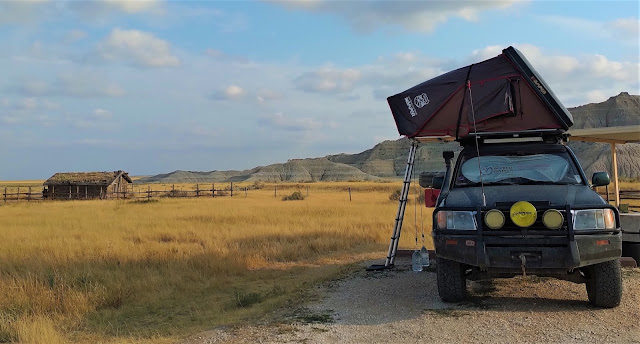Leaving Buffalo Gap National Grasslands, South Dakota I was heading south on SR71 entering the Nebraska panhandle and the Oglala National Grasslands. Toadstool Geologic Park was on my GPS and I was fascinated about traveling through time about 30 million years worth. Before Crawford in Sioux county it was another world.
The stark other-worldly landscape is home to no other in Nebraska. Yet its barren hills and rock-strewn gullies disguise the abundant life it once supported. Miniature horses, hump-less camels, gigantic tortoises, pigs and even rhinoceroses roamed here. All that remains of theses beasts are bits of fossilized bone and tracks imprinted in the once soft mud. Millions of years ago these prehistoric mammals came to drink on the shores of this ancient river valley.
The water carried volcanic debris that layer upon layer formed rocks that are seen today. Even more time water and wind sculpted the rock into Badlands, (see previous post 11.30.21 Summer Expedition Badlands National Park, 2021 series).
So why is it called Toadstool? The first visitors in the late 1800's must have felt they were traveling through giant mushrooms. Labeling the jumble of sandstone slabs resting upon their clay pillars, toadstools. Hence the name that stuck. Toadstools are created by the forces of wind and water, eroding the soft clay faster than the hard sandstone rock that caps it. Erosion eventually collapses the giant toadstools while new ones form.
Volcanoes from the west periodically blanketed this area with ash. Water from rain and snow dissolved the ash and seeped into cracks in the clay. As clay eroded, the hardened minerals (silicon dioxide same compound as glass), bone fragments and foot prints of long ago dead animals became exposed, and is what we see today. Years from now as erosion continues at about 1 inch a year, imagine what else will be exposed.
The park has many things to discover along the winding trails and a spacious campground is at its door step. Camping here in the midst of the golden grasslands is as peaceful as it is beautiful. The night time skies light up like a hot disco in Soho as a passing storm rumbles across the plains. Earthen roof of a settlers sod-brick cabin still stands and is as incredible to walk in the company of what has been so long in the making. Even the odd shaped modern day drainage pipe resting in limbo seems out of place, but doesn't.
About 60 miles outside of Crawford is the Agate Fossil Beds National Monument. Around 20 million years ago drought struck the western plains of Nebraska. Deprived food to great herds of plant-eating mammals and their predators, who died around a few shallow watering holes. Over time their skeletal remains were buried in the silt, fine sand, and volcanic ash carried by the wind and reworked streams.
An ancient waterhole with hundreds of fossilized skeletons is preserved in the Niobrara River valley at Agate Fossil Beds National Monument, stunning views and formations are just the surface of the North American Great Plains.This is where I make my loop west heading back into Wyoming and the Medicine Bow National Forest.
Hope to see you on the Trail!!..
🚙.........




























